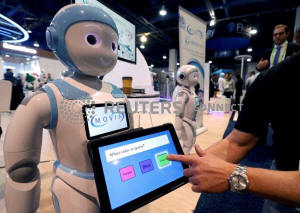|
'AI' to hit hardest in U.S. heartland and
among less-skilled: study
 Send a link to a friend
Send a link to a friend
 [January 24, 2019]
WASHINGTON (Reuters) - The
Midwestern states hit hardest by job automation in recent decades,
places that were pivotal to U.S. President Donald Trump's election, will
be under the most pressure again as advances in artificial intelligence
reshape the workplace, according to a new study by Brookings Institution
researchers. [January 24, 2019]
WASHINGTON (Reuters) - The
Midwestern states hit hardest by job automation in recent decades,
places that were pivotal to U.S. President Donald Trump's election, will
be under the most pressure again as advances in artificial intelligence
reshape the workplace, according to a new study by Brookings Institution
researchers.
The spread of computer-driven technology into middle-wage jobs like
trucking, construction, and office work, and some lower-skilled
occupations like food preparation and service, will also further divide
the fast-growing cities where skilled workers are moving and other
areas, and separate the high- skilled workers whose jobs are less prone
to automation from everyone else regardless of location, the study
found.
(Jobs most at risk of automation by state: https://tmsnrt.rs/2HpTe5H)
But the pain may be most intense in a familiar group of
manufacturing-heavy states like Wisconsin, Ohio and Iowa, whose support
swung the U.S. electoral college for Trump, a Republican, and which have
among the largest share of jobs, around 27 percent, at "high risk" of
further automation in coming years.

At the other end, solidly Democratic coastal states like New York and
Maryland had only about a fifth of jobs in the high-risk category.
The findings suggest the economic tensions that framed Trump's election
may well persist, and may even be immune to his efforts to shift global
trade policy in favor of U.S. manufacturers.
(Occupations by automation potential: https://tmsnrt.rs/2HuJK9f)
"The first era of digital automation was one of traumatic change...with
employment and wage gains coming only at the high and low ends," authors
including Brookings Metro Policy Program director Mark Muro wrote of the
spread of computer technology and robotics that began in the 1980s.
"That our forward-looking analysis projects more of the same...will not,
therefore, be comforting."
[to top of second column]
|

Jean Pierre "JP" Bolat demonstrates Movia Robotics educational
software for children with autism on an Avatarmind iPal robot during
the 2019 CES in Las Vegas, Nevada, U.S. January 9, 2019.
REUTERS/Steve Marcus/File Photo

The study used prior research from the McKinsey Global Institute
that looked at tasks performed in 800 occupations, and the
proportion that could be automated by 2030 using current technology.
While some already-automated industries like manufacturing will
continue needing less labor for a given level of output - the
"automation potential" of production jobs remains nearly 80 percent
- the spread of advanced techniques means more jobs will come under
pressure as autonomous vehicles supplant drivers, and smart
technology changes how waiters, carpenters and others do their jobs.
That would raise productivity - a net plus for the economy overall
that could keep goods cheaper, raise demand, and thus help create
more jobs even if the nature of those jobs changes.
But it may pose a challenge for lower-skilled workers in particular
as automation spreads in food service and construction, industries
that have been a fallback for many.
"This implies a shift in the composition of the low-wage workforce"
toward jobs like personal care, with an automation potential of 34
percent, or building maintenance, with an automation potential of
just 20 percent, the authors wrote.
(Reporting by Howard Schneider; Editing by Andrea Ricci)
[© 2019 Thomson Reuters. All rights
reserved.]
Copyright 2019 Reuters. All rights reserved. This material may not be published,
broadcast, rewritten or redistributed.
Thompson Reuters is solely responsible for this content.
 |